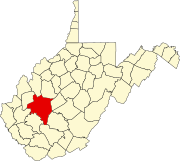Malden, West Virginia
Malden, West Virginia | |
|---|---|
 Malden Location within West Virginia and the United States | |
| Coordinates: 38°18′02″N 81°33′25″W / 38.30056°N 81.55694°WCoordinates: 38°18′02″N 81°33′25″W / 38.30056°N 81.55694°W | |
| Country | United States |
| State | West Virginia |
| County | Kanawha |
| Time zone | UTC-5 (Eastern (EST)) |
| • Summer (DST) | UTC-4 (EDT) |
| ZIP codes | 25306 |
Malden — originally called Kanawha Salines — is an unincorporated community in Kanawha County, West Virginia, United States,[1] within the Charleston metro area.
History[]
The Kanawha Saline(s) post office was established in 1814 and discontinued in 1879.[2] The community changed its name to Malden, establishing Malden PO in 1879; it closed in 1961.[2] This probably means that Malden became a Rural Branch of Charleston in 1961. The present name most likely is derived from Malden, Massachusetts.[3]
Arts and culture[]
Malden is the location of the Salines salt wells,[4] and the Booker T. Washington Park, owned and maintained by the West Virginia State University.
The African Zion Baptist Church and Malden Historic District are listed on the National Register of Historic Places.[5]
Notable people[]
Notable people from Malden include General Lewis Ruffner and his wife Viola Ruffner, and Booker T. Washington, president of Tuskegee Institute and a national African-American leader in the early 20th century.[4]
References[]
- ^ U.S. Geological Survey Geographic Names Information System: Malden, West Virginia
- ^ Jump up to: a b Helbock, Richard W. (2004) United States Post Offices, Volume VI - The Mid-Atlantic, p. 135, Scappoose, Oregon: La Posta Publications.
- ^ Kenny, Hamill (1945). West Virginia Place Names: Their Origin and Meaning, Including the Nomenclature of the Streams and Mountains. Piedmont, WV: The Place Name Press. pp. 398–399.
- ^ Jump up to: a b Easter, Makeda (2020-04-16). "Slavery documents from Southern saltmakers bring light to dark history". Los Angeles Times. Retrieved 2020-04-17.
- ^ "National Register Information System". National Register of Historic Places. National Park Service. July 9, 2010.
- Unincorporated communities in Kanawha County, West Virginia
- Unincorporated communities in West Virginia
- Populated places on the Kanawha River
- Kanawha County, West Virginia geography stubs


